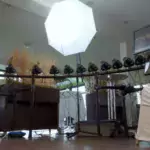This drumming booth is decked out with all sorts of Raspberry Pi-powered paraphernalia. From a touchscreen interface controlling the lights to a multicamera recording setup.
Frank Delporte is a very handy dad to have if you’re planning to find YouTube fame as a drummer. He has over ten years of experience in video and multimedia, and also happens to be a software developer with a penchant for Raspberry Pi-powered projects.

Back in 2019, Frank completed a DIY drumming booth for his son, Vik. While it did the job of reducing the noise coming through to the living room, the next part of the process was to make it a million times cooler by throwing several Raspberry Pis at it.
Light control
A seven-inch touchscreen inside the drumming booth allows Vik to change the colour and speed of the booth’s LED strips. A Raspberry Pi 3B+ works together with an Arduino Uno that powers switches that trigger the lights.

Alongside the in-booth control running on Java, there is also a web server Frank can use from inside the house so he can trigger the lights to signal that dinner is ready, or that they’ve heard that particular System of a Down beat enough times this evening. I’m not entirely sure what luminous language they’ve come up with to communicate through LEDs, but it seems to be working.

Frank has shared all the source code, wiring schemes, and setup details for the controllable light show on his website.
Multicam recording
The next step on the path to creating a most excellent drumming booth was installing multiple cameras to record Vik’s drum performances. Frank’s Raspberry Pi-powered set up captures Vik from three different angles while he’s playing and records it in a format ready to edit and upload to YouTube.

The current [experimental] set up comprises:
- Two Raspberry Pi Zero 2 W, each powering a High Quality Camera Module
- A Raspberry Pi 4 powering a Waveshare fisheye lens camera
- ATEM Mini switcher records to USB disc
- Yamaha EAD10 (the drum set’s microphone)
All three Raspberry Pis are connected to the ATEM Mini via HDMI. Each one feeds the video footage captured by the cameras they power. Audio from the Yamaha EAD10 is captured separately.
At the moment, they use DaVinci Resolve software to combine and edit all the multimedia elements for broadcast. Frank is currently working on an automated solution that will feed the audio directly into the ATEM Mini. This will eliminate the software needed to combine separate video and audio feeds, and would allow Vik to livestream his performances.
Read more about this aspect of the drumming booth on Frank’s website.
Let’s make KazachKingMusic YouTube famous
Vik’s YouTube channel has a handful of drumming performances up already and there’s plenty more to come now that the booth is nearing completion. My personal fave is the performance of Queen’s “Radio Ga Ga” (I don’t know any of the other songs because I have been listening exclusively to BBC Radio 2 since 2007).
Be kind and subscribe, even if only to keep an eye on the next Pi-powered installation Vik’s dad finds space for inside the booth.








